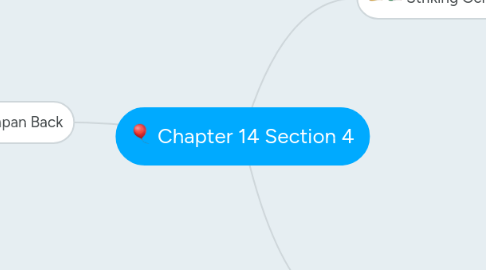
1. Driving Japan Back
1.1. Island-Hopping in the Pacific
1.1.1. There was only one vehicle able to cross the reef and deliver its troops onto the beaches. The vehicle was a boat with tank tracks, nicknamed the “Alligator.” This amphibious tractor, or amphtrac, had been invented in the late 1930s to rescue people in Florida swamps.
1.1.2. After the Marshall Islands, the navy targeted the Mariana Islands. American military planners wanted to use the Marianas as a base for a new heavy bomber, the B-29 Superfortress. The B-29 could fly farther than any other plane in the world.
1.2. MacArthur Returns
1.2.1. General Douglas MacArthur's troops began a campaign in the southwest Pacific. The campaign began by invading Guadalcanal in the Solomon Islands, east of New Guinea, in August 1942. It continued until early 1944, when MacArthur’s troops finally captured enough islands to surround the main Japanese base in the region.
2. Striking Germany and Italy
2.1. Strategic Bombing
2.1.1. Britain's Royal Air Force dropped an average of 2,300 tons of explosives on Germany every month for three years
2.1.2. These bombs didn't destroy Germany’s economy or undermine German morale, but it did cause a severe oil shortage and wrecked the railroad system.
2.2. Striking the Soft Underbelly
2.2.1. The invasion began on July 10, 1943. Eight days after the troops came ashore, American tanks smashed through enemy lines and took over half the island.
2.2.2. The attack on Sicily created a crisis within the Italian government. The king of Italy, Victor Emmanuel, and a group of Italian generals decided that it was time to depose Mussolini. Mussolini was arrested and the Italian government began negotiating to surrender to the allies
2.3. The Tehran Conference
2.3.1. Roosevelt, Stalin, and Churchill met in Tehran, Italy to discuss things before the Allies invaded France
2.3.2. Ultimately, Roosevelt and Stalin agreed to divide Germany after the war so they could no longer mess with world peace
3. Landing in France
3.1. Planning Operation Overlord
3.1.1. The Allies placed dummy equipment along the coast across from Calais as decoys. The real target was to be further south, at five beaches covering a 60-mile spread along the Normandy coast.
3.1.2. Knowing that the Allies would eventually invade France, Hitler had fortified the coast along the English Channel. The Allies did have the advantage of surprise, because the Germans did not know when or where the Allies would land. The Germans believed the Allies would land in Pas-de-Calais, the area of France closest to Britain.
3.2. Longest Day
3.2.1. The American landing at Utah Beach went well. The German defenses were weak, and in less than three hours the troops had captured the beach and moved inland, suffering fewer than 200 casualties. On the eastern flank, the British and Canadian landings also went well. By the end of the day, British and Canadian forces were several miles inland.
3.2.2. Omaha Beach, however, was a different story. Under intense German fire, the American assault almost disintegrated. Slowly, the American troops began to knock out the German defenses. At the end of the day the operation was successful.

